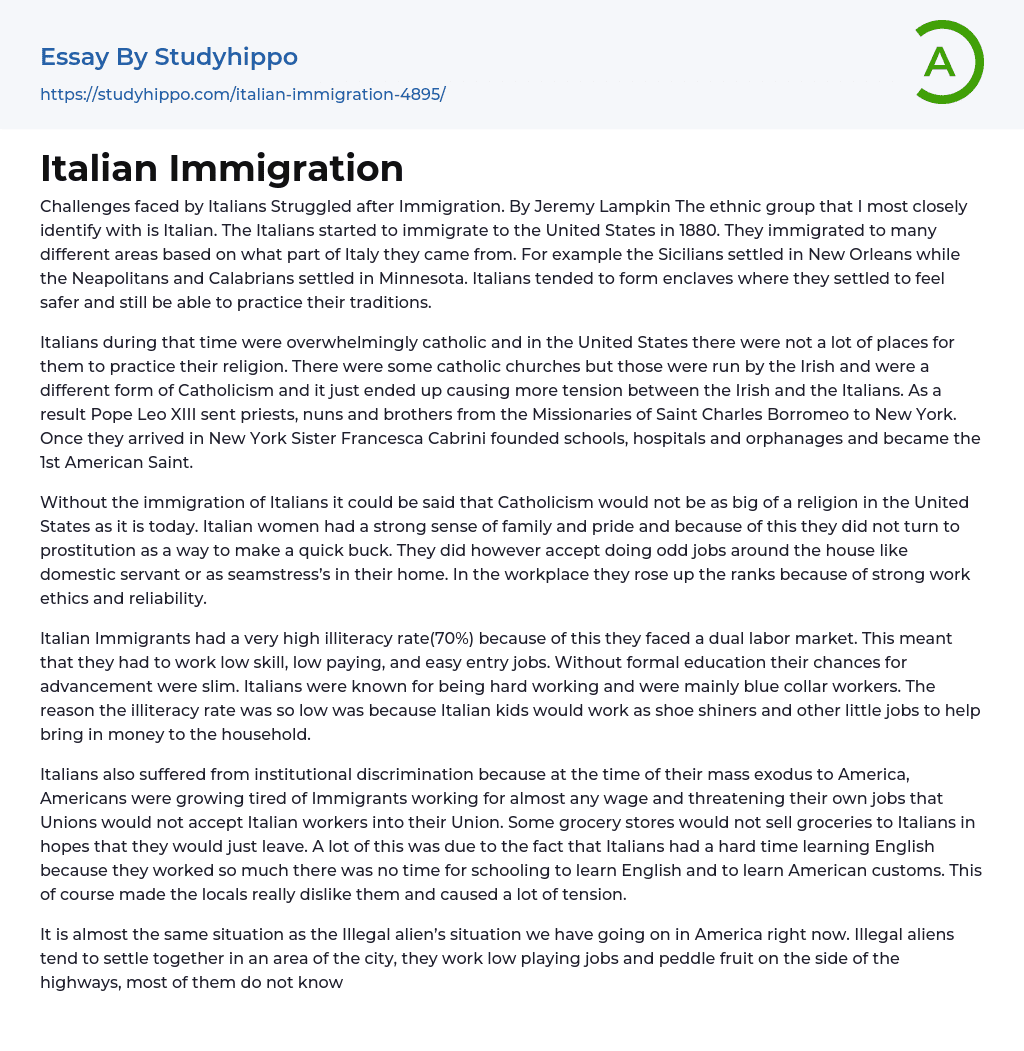Challenges faced by Italians Struggled after Immigration. The ethnic group that I most closely identify with is Italian. The Italians began immigrating to the United States in 1880, settling in various regions depending on their origin within Italy. For instance, the Sicilians established their community in New Orleans, while the Neapolitans and Calabrians settled in Minnesota. Italians often formed enclaves in their new settlements, both to ensure their safety and to uphold their cultural traditions.
Italians in that era were predominantly Catholic, and in the United States, there were limited options for them to practice their religion. Though there were some Catholic churches, they were predominantly overseen by the Irish and followed a distinct form of Catholicism, exacerbating the tensions between the Irish and Italians. In response, Pope Leo XIII dispatched priests, nuns, and brothers from the Missionaries of Saint Charles Borromeo to New
...York. Upon their arrival, Sister Francesca Cabrini established schools, hospitals, and orphanages, ultimately becoming the first American Saint.
The immigration of Italians greatly influenced the prominence of Catholicism in present-day United States. Italian women's strong dedication to family and pride prevented them from turning to prostitution for fast cash, leading them to embrace domestic occupations like being a servant or seamstress within their households. Their outstanding work ethics and dependability propelled them to higher positions in the workforce.
Italian Immigrants faced a dual labor market due to their high illiteracy rate, which stood at 70%. As a result, they were limited to low skill, low paying, and easy entry jobs, making advancement opportunities scarce. Italian immigrants were often categorized as hardworking individuals, predominantly occupying blue collar positions. To contribute financially to their households, Italia
children would engage in tasks such as shoe shining and other small jobs.
Italians experienced institutional discrimination during their mass immigration to America. This was because Americans were becoming weary of immigrants working for low wages and potentially taking away their own jobs. Unions refused to accept Italian workers, and some grocery stores even refused to sell groceries to Italians in the hope that they would leave. The main reason for this discrimination was that Italians had limited opportunities to learn English and adapt to American customs due to their demanding work schedules. As a result, this created animosity among the locals and generated significant tension.
The situation in America regarding Illegal aliens is reminiscent of the situation with Italians in the past. Illegal aliens tend to congregate in a specific area of the city, engaging in low-wage employment and vending fruit along highways. A significant portion of them struggle with English language proficiency and literacy. Both groups encounter prejudiced stereotypes within their workplaces. Strikingly, these two scenarios are more alike than I originally perceived. Italians also endured stereotypes, particularly being linked to organized crime, which persists even today. Such stereotypes further led to Italians experiencing redlining as victims.
The stereotype that Italian neighborhoods are violent and controlled by organized crime makes it very challenging for Italians to find housing in non-poor neighborhoods. This stereotype continues today, with over two-thirds of the 2,000 films analyzed by the Italic Institute of America depicting Italians as part of organized crime. However, FBI statistics reveal that only 3,000 Italians are associated with the "Mafia," meaning that only one in every 6,000 Italian Americans has a link to organized crime.
I feel a
strong connection to both mainstream culture and Italian culture. While I didn't grow up with all the traditions, there are similarities that I can relate to. However, some aspects, like being non-Catholic while most Italians are, don't resonate with me. Growing up in American mainstream culture has had a big impact on me. Embracing both cultures is important as it adds diversity and contributes to the greatness of the United States.
Reference Page
Mintz, S. (2007). Italian Immigration. In Digital History. Retrieved February 12, 2012.
Rapczynski, J. (1999). In The Italian Immigration Experience in America. Retrieved February 12, 2012.
Unknown. (2004). The Story of Italian Immigration. In The Story of Italian Immigration. Retrieved February 12, 2012.
- Migration essays
- Human Migration essays
- Illegal Immigration essays
- Immigrants essays
- Refugee essays
- Abortion essays
- Abuse essays
- Animal Rights essays
- Animal Testing essays
- Assault essays
- Bullying essays
- Controversial Issue essays
- Crash essays
- Cyber Bullying essays
- Feminism essays
- Human Rights essays
- Immigration essays
- Inequality essays
- Poverty essays
- Prejudice essays
- Racism essays
- Torture essays
- Violence essays
- Athens essays
- Belgium essays
- Berlin essays
- British essays
- England essays
- Germany essays
- Great britain essays
- Greece essays
- Ireland essays
- Italy essays
- London essays
- Paris essays
- Pompeii essays
- Rome essays
- Russia essays
- Spain essays
- United Kingdom essays
- Animal Cruelty essays
- Charles Manson essays
- Crime Prevention essays
- Crime scene essays
- Criminal Justice essays
- Criminology essays
- Cyber Crime essays
- Damages essays
- Detention essays
- Distracted Driving essays




